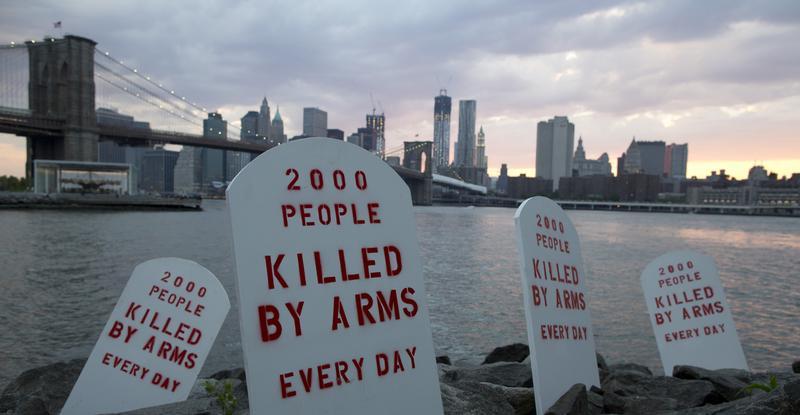For years governments told us in meetings that an Arms Trade Treaty was a fanciful idea – merely a twinkle in our campaigning eye. But earlier this month an Arms Trade Treaty was adopted by an overwhelming majority at the United Nations General Assembly. Thanks to the democratic process, international law will for the first time regulate the $70 billion global arms trade.
When we launched the Control Arms campaign more than a decade ago, only Mali, Costa Rica and Cambodia were prepared to publicly stand with us in demanding the treaty.
But things started to change.
Dogged perseverance, growing recognition that the arms trade was out of control and a campaign around the world began to pay off. The UK government’s announcement of support in 2004 was a turning point; many other major arms exporters followed suit. By 2005, more than 50 countries supported the idea.
Crucially, in 2006 the ATT process itself began inside the U.N. at the General Assembly First Committee on Disarmament and Security. A resolution, introduced by seven core governments (Argentina, Australia, Costa Rica, Kenya, Japan, Finland and the UK) and vigorously advocated for by the Control Arms Coalition, gained more than 100 co-sponsors. The resolution passed in a landslide votein the General Assembly, 153 to 1 (the U.S. was the no vote), with 24 abstentions.
Had the process been launched in the consensus-bound Conference on Disarmament in Geneva ‑ currently in its 12th year of meeting without even being able to agree an agenda ‑ chances are it would never have left the starting blocks.
Many U.N. processes are deeply frustrating. The most common complaint is how long it takes to get things done. Sometimes, agreement is never reached.
The requirement to reach consensus is in principle a means of protecting the rights and voices of even the smallest countries. It’s what can enable small island states and other vulnerable countries to stand their ground in the U.N. climate change negotiations. But too often the consensus rule works to protect the powerful, not the powerless. Big powers love consensus because it gives them veto power. Time and again, Russia and China, in particular, have used their veto in the Security Council to override the will of the majority.
As we saw last week on the last day of the ATT negotiations, the extension of this consensus rule can also mean that regimes such as Syria, North Korea and Iran can hold the rest of the world hostage – in this case, at least for a few days.
Striving for consensus is, of course, sensible. The problem is that it can lead to a lowest-common-denominator approach. The balance of power shifts to those – often the minority – who oppose an issue, because all the effort goes into trying to persuade them not to bring everything to a shuddering halt. And whoever is chairing knows supporters will tend to be more flexible than skeptics.
During the two-week-long final conference, many states expressed unhappiness about the process. They felt the skeptics were being listened to too much, at the expense of everyone else. Halfway through the conference, Ghana, on behalf of more than 100 governments, delivered a statement that threw down the gauntlet to the president of the conference, Peter Woolcott, calling on him to listen more to the majority of states working for a strong treaty, not the minority intent on wrecking it.
But with Syria, North Korea and Iran in the room, achieving consensus was always going to be very difficult – and thus many were not surprised when it failed to emerge on the final day of the conference. Mexico, supported by Japan, Nigeria and others, made an attempt to persuade the room that since the majority clearly wanted the treaty, the president should push ahead.
A clever plan B was needed, and fortunately we had worked hard last October during the General Assembly session to make sure we had one. Progressive governments and the Control Arms Coalition lobbied hard to get a small but vital paragraph into the resolution that would take any blocked text to the General Assembly.
We had studied the precedents. The Comprehensive Test Ban Treaty, which was adopted by vote following India blocking consensus, was the best example. As it turned out, that paragraph proved to be crucial; it was what enabled the blocked consensus text to go forward so quickly to vote, just five days after the final day of negotiations.
In a sudden about-face, the United States, the government that had insisted on consensus as the condition for its support throughout the negotiating process, switched to calling for a vote as soon a possible. It even co-sponsored the resolution, something it had never done before. Possibly, this was in response to intense external pressure, but also it seemed like the U.S. side was more coordinated than it had been in previous debates.
This may not mean the United States now supports the majority process – but changing horses during the race meant the Americans could use the consensus process to get the text they wanted and then, by supporting the resolution, they could ensure it went to a vote and passed.
Tuesday, April 2, was a good day for the U.N. It showed that things can get done. It showed that the democratic process can work. And it set an important precedent.
Does it make any difference, legally, that the treaty was adopted by vote, not consensus? No. It is the same text as on the final day of negotiations, and its legal status is the same as if it had been agreed by consensus. But it should give hope to those working on other seemingly intractable issues that you can change the rules of the game and make progress.
Anna McDonald is head of the Control Arms campaign for Oxfam.
This article was first published on Reuters on April 9th 2013.


 Doris*, daughter, 5; Pamila*, 2. Christina grows maize and she was shown how to make compost as part of the CRAFS (Climate Resilient Agriculture and Food Systems) programme.
Doris*, daughter, 5; Pamila*, 2. Christina grows maize and she was shown how to make compost as part of the CRAFS (Climate Resilient Agriculture and Food Systems) programme.
